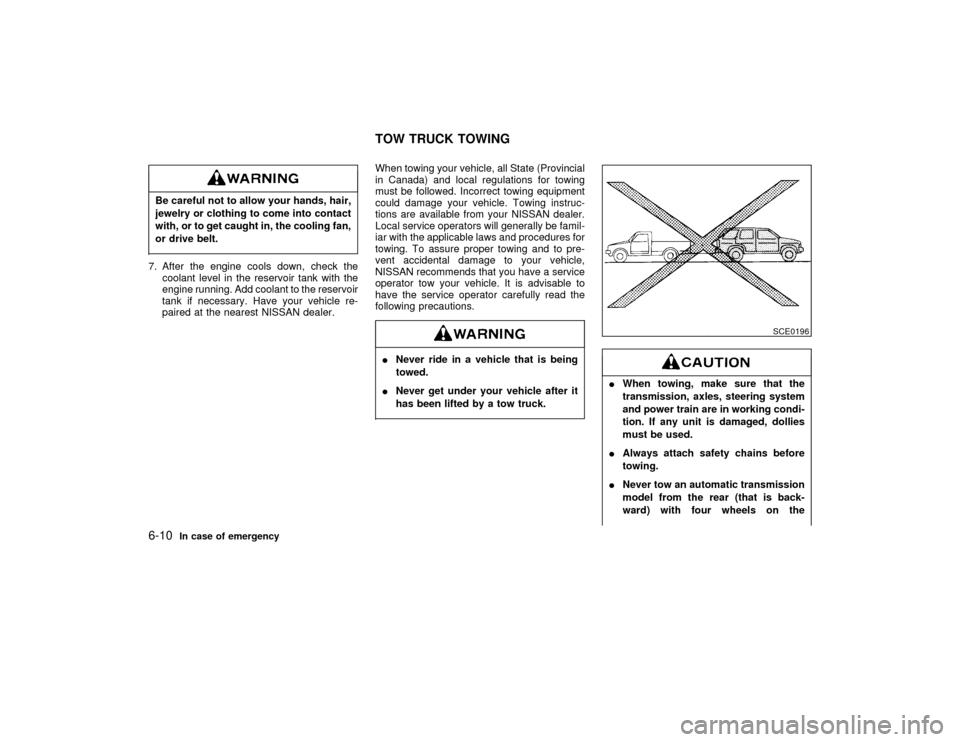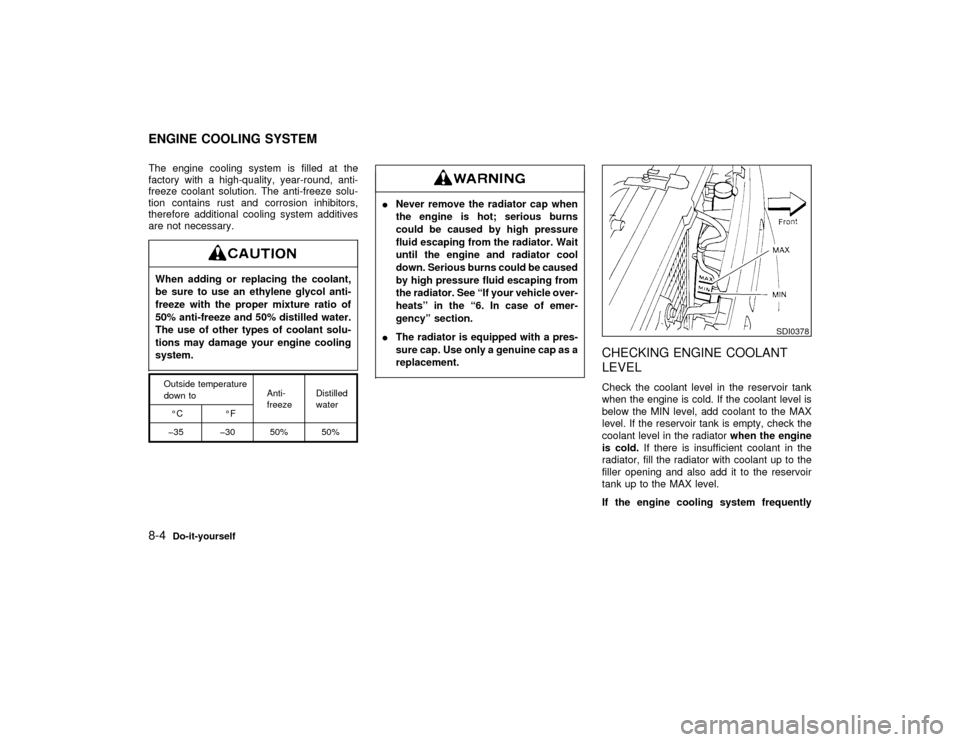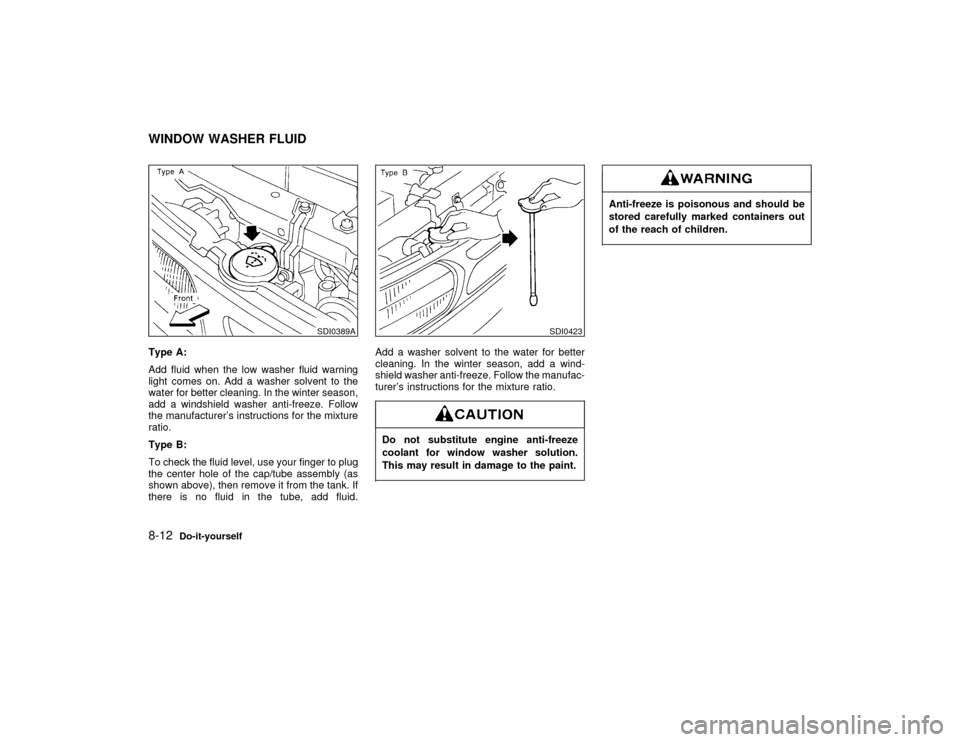1998 NISSAN PATHFINDER coolant level
[x] Cancel search: coolant levelPage 165 of 249

Be careful not to allow your hands, hair,
jewelry or clothing to come into contact
with, or to get caught in, the cooling fan,
or drive belt.7. After the engine cools down, check the
coolant level in the reservoir tank with the
engine running. Add coolant to the reservoir
tank if necessary. Have your vehicle re-
paired at the nearest NISSAN dealer.When towing your vehicle, all State (Provincial
in Canada) and local regulations for towing
must be followed. Incorrect towing equipment
could damage your vehicle. Towing instruc-
tions are available from your NISSAN dealer.
Local service operators will generally be famil-
iar with the applicable laws and procedures for
towing. To assure proper towing and to pre-
vent accidental damage to your vehicle,
NISSAN recommends that you have a service
operator tow your vehicle. It is advisable to
have the service operator carefully read the
following precautions.
INever ride in a vehicle that is being
towed.
INever get under your vehicle after it
has been lifted by a tow truck.
IWhen towing, make sure that the
transmission, axles, steering system
and power train are in working condi-
tion. If any unit is damaged, dollies
must be used.
IAlways attach safety chains before
towing.
INever tow an automatic transmission
model from the rear (that is back-
ward) with four wheels on the
SCE0196
TOW TRUCK TOWING
6-10
In case of emergency
Z
01.1.31/R50-D
X
Page 179 of 249

The engine cooling system is filled at the
factory with a high-quality, year-round, anti-
freeze coolant solution. The anti-freeze solu-
tion contains rust and corrosion inhibitors,
therefore additional cooling system additives
are not necessary.When adding or replacing the coolant,
be sure to use an ethylene glycol anti-
freeze with the proper mixture ratio of
50% anti-freeze and 50% distilled water.
The use of other types of coolant solu-
tions may damage your engine cooling
system.Outside temperature
down toAnti-
freezeDistilled
water
ÉC ÉF
þ35 þ30 50% 50%
INever remove the radiator cap when
the engine is hot; serious burns
could be caused by high pressure
fluid escaping from the radiator. Wait
until the engine and radiator cool
down. Serious burns could be caused
by high pressure fluid escaping from
the radiator. See ªIf your vehicle over-
heatsº in the ª6. In case of emer-
gencyº section.
IThe radiator is equipped with a pres-
sure cap. Use only a genuine cap as a
replacement.
CHECKING ENGINE COOLANT
LEVELCheck the coolant level in the reservoir tank
when the engine is cold. If the coolant level is
below the MIN level, add coolant to the MAX
level. If the reservoir tank is empty, check the
coolant level in the radiatorwhen the engine
is cold.If there is insufficient coolant in the
radiator, fill the radiator with coolant up to the
filler opening and also add it to the reservoir
tank up to the MAX level.
If the engine cooling system frequently
SDI0378
ENGINE COOLING SYSTEM8-4
Do-it-yourself
Z
01.1.31/R50-D
X
Page 181 of 249

1. Perform the following procedure to open
the heater water cock.
ITurn the ignition key from OFF to ON.
IMove the heater or air conditioner tem-
perature control dial to the maximum hot
position then turn the ignition key to
OFF.
2. Open the radiator drain plug and radiator
cap.
Open the drain plugs on the engine block.3. Open the air release plug to drain the
coolant.
4. Flush the cooling system by running fresh
water through the radiator.
5. Close the radiator drain plug and engine
block drain plugs securely.
6. See the ªTechnical informationº section for
cooling system capacity.
Fill the radiator slowly with the proper mix-
ture of coolant and water. Fill the reservoir
tank slowly up to the MAX level. Then install
the radiator cap and close the air release
plug.7. Start the engine and warm it up until it
reaches normal operating temperature.
Then race the engine 2 or 3 times under no
load.
Watch the coolant temperature gauge for
signs of overheating.
8. Stop the engine. After it completely cools
down, refill the radiator up to the filler
opening. Fill the reservoir tank up the MAX
level.
9. Check the radiator drain plug and engine
block drain plugs for any sign of leakage.
SDI0409
SDI0410
SDI0419
8-6
Do-it-yourself
Z
01.1.31/R50-D
X
Page 187 of 249

Type A:
Add fluid when the low washer fluid warning
light comes on. Add a washer solvent to the
water for better cleaning. In the winter season,
add a windshield washer anti-freeze. Follow
the manufacturer's instructions for the mixture
ratio.
Type B:
To check the fluid level, use your finger to plug
the center hole of the cap/tube assembly (as
shown above), then remove it from the tank. If
there is no fluid in the tube, add fluid.Add a washer solvent to the water for better
cleaning. In the winter season, add a wind-
shield washer anti-freeze. Follow the manufac-
turer's instructions for the mixture ratio.
Do not substitute engine anti-freeze
coolant for window washer solution.
This may result in damage to the paint.
Anti-freeze is poisonous and should be
stored carefully marked containers out
of the reach of children.
SDI0389A
SDI0423
WINDOW WASHER FLUID8-12
Do-it-yourself
Z
01.1.31/R50-D
X
Page 211 of 249

Parking brake*Check that the lever has the
proper travel and confirm that your vehicle is
held securely on a fairly steep hill with only the
parking brake applied.
Automatic transmission P position mecha-
nismOn a fairly steep hill check that your
vehicle is held securely with the selector lever
in the P position without applying any brakes.Under the hood and vehicleThe maintenance items listed here should be
checked periodically e.g. each time you check
the engine oil or refuel.
Windshield washer fluid*Check that there is
adequate fluid in the tank.
Engine coolant level*Check the coolant level
when the engine is cold.
Radiator and hosesCheck the front of the
radiator and clean off any dirt, insects, leaves,
etc., that may have accumulated. Make sure
the hoses have no cracks, deformation, rot or
loose connections.
Brake and clutch fluid levels*Make sure that
the brake and clutch fluid level is between the
MAX and MIN lines on the reservoir.
Battery*Check the fluid level in each cell. Itshould be between the MAX and MIN lines.
Engine drive belts*Make sure that no belt is
frayed, worn, cracked or oily.
Engine oil level*Check the level after parking
the vehicle on a level spot and turning off the
engine. (Be sure to wait a few minutes to allow
the oil to drain back into the sump.)
Power steering fluid level* and linesCheck
the level when the fluid is cold and the engine
is turned off. Check the lines for proper attach-
ment, leaks, cracks, etc.
Automatic transmission fluid level*Check
the level after putting the selector lever in P
(Park) with the engine idling.
Exhaust systemMake sure there are no
loose supports, cracks or holes. If the sound of
the exhaust seems unusual or there is a smell
of exhaust fumes, immediately locate the
trouble and correct it. See ªPrecautions when
starting and drivingº in the ª5. Starting and
drivingº section for exhaust gas (carbon mon-
oxide).
UnderbodyThe underbody is frequently ex-
posed to corrosive substances such as those
used on icy roads or to control dust. It is veryimportant to remove these substances, other-
wise rust will form on the floor pan, frame, fuel
lines and around the exhaust system. At the
end of winter, the underbody should be thor-
oughly flushed with plain water, being careful
to clean those areas where mud and dirt may
accumulate. For additional information, see
ªCleaning exteriorº in the ª7. Appearance and
careº section.
Fluid leaksCheck under the vehicle for fuel,
oil, water or other fluid leaks after the vehicle
has been parked for a while. Water dripping
from the air conditioner after use is normal. If
you should notice any leaks or if gasoline
fumes are evident, check for the cause and
have it corrected immediately.9-4
Maintenance
Z
01.1.31/R50-D
X
Page 243 of 249

Checking
Brake pedal ............................................... 8-18
Bulb ............................................................. 2-9
Engine coolant level .................................... 8-4
Engine oil level ............................................ 8-7
Parking brake ............................................ 8-18
Seat belt operation, Three-point ............... 1-21
Child restraint.................................................. 1-25
Installation on front seat ............................ 1-36
Installation on rear seat center ................. 1-27
Installation on rear seat outboard ............. 1-30
Precaution ................................................. 1-25
Top strap ................................................... 1-34
Child safety
Rear door lock ............................................. 3-3
Seat belt .................................................... 1-18
Chrome parts, Cleaning .................................... 7-3
Cigarette lighter and ashtray .......................... 2-22
Cleaner, Air ..................................................... 8-16
Cleaning
Exterior ........................................................ 7-2
Interior ......................................................... 7-4
Clock ............................................................... 2-33
Adjusting .................................................... 2-33
Operation ................................................... 2-34
Clutch
Fluid ........................................................... 8-11
Housing drain,
................................. 8-30
Pedal ......................................................... 8-20
Cold weather driving ....................................... 5-26
Compact disc (CD) player operation, with
cassette player type........................................ 4-23
Compass display .............................................. 2-7
Console box .................................................... 2-25Controls, Heater and manual air conditioner.... 4-3
Controls, Heater and semiautomatic air
conditioner ........................................................ 4-9
Cooling system, Engine .................................... 8-4
Corrosion protection ......................................... 7-5
Cover, Tonneau .............................................. 2-29
Cruise control.................................................. 5-16
Cup holder ...................................................... 2-24
D
Defogger switch, Rear window and outside
mirror............................................................... 2-16
Dimensions and weights, Vehicle ................. 10-11
Door .................................................................. 3-2
Door open warning light ................................. 2-10
Drinking alcohol/drugs and driving ................... 5-4
Drive belt......................................................... 8-14
Driving
Cold weather ............................................. 5-26
On snow or ice .......................................... 5-28
On-pavement and offroad ........................... 5-4
Precaution ................................................... 5-2
The vehicle .................................................. 5-9
Drugs ................................................................ 5-4
EEconomy, Fuel ................................................ 5-19
Emission control
Information label ...................................... 10-13
System warranty...................................... 10-19
Engine
Block heater .............................................. 5-28Compartment check location....................... 8-3
Coolant heater ........................................... 5-28
Coolant temperature gauge ........................ 2-4
Cooling system ............................................ 8-4
Oil ................................................................ 8-7
Oil and oil filter recommendation .............. 10-6
Overheat ...................................................... 6-9
Serial number .......................................... 10-12
Specifications ............................................ 10-9
Exhaust gas (Carbon monoxide) ...................... 5-2
Explanation of maintenance items .......... 9-2, 9-10
Exterior and interior light, Replacement ......... 8-23
F
F.M.V.S.S. certification label......................... 10-13
Fastening the seat belt
Three-point ................................................ 1-20
Two-point ................................................... 1-23
Filling, Fuel filler lid ......................................... 3-11
Filter, Air ......................................................... 8-16
Flasher switch, Hazard warning ..................... 2-19
Flat tire .............................................................. 6-2
Floor mats, Cleaning ........................................ 7-4
Fluid
Automatic transmission ............................... 8-9
Brake ......................................................... 8-11
Engine ......................................................... 8-7
Power steering .......................................... 8-11
Window washer ......................................... 8-12
Fog light switch ............................................... 2-19
Four by four clutch housing drain ................... 8-30
Four wheel drive, Using .................................. 5-20
Z
01.1.31/R50-D
X
11-2